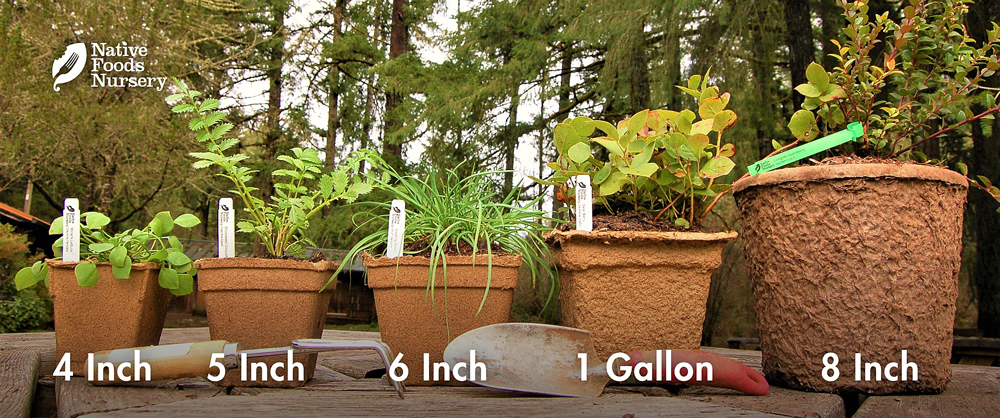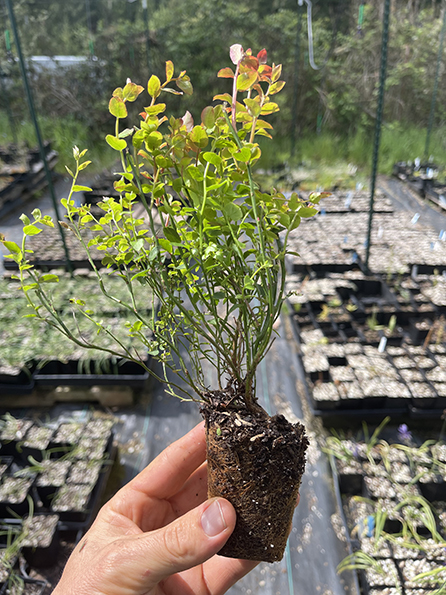Red Huckleberry


- Current Stock:
- 0
- Other Names:
- Red Whortleberry, Red Bilberry
- Latin Name:
- Vaccinium parviflorum
Red Huckleberry is a Northwest berry bush with tasty and healthy fruit.
Edible Uses
Red Huckleberry produces a tart and tangy berry ranging from red to pink to orange. Many prefer the flavor of red huckleberry to cranberries, and use them in similar recipes. They can add a nice depth of flavor to other milkshakes and cobblers made with other sweeter berries, or on their own for those of us who enjoy more tang! They can be preserved into jams, fruit leathers, frozen for smoothies, dried for teas and huckleberry “raisins”, or simmered down into a sweet and tart sauce to be paired with savory autumnal dishes.
In addition to their many culinary applications, the berries are a native food high in vitamin C and are rich in antioxidants. The dried leaves and stems can be collected in late summer and early fall, to be used as an astringent tea which can ease diarrhea. Other uses include gargling the tea for sore throats and inflamed gums.
NOTE: Being a wild plant, fruit production and growth speed is significantly lower than a cultivated Blueberry bush. Grown from wild seed, they have a wide genetic diversity, and are known to be variable in their flavor, production, and site preferences. Due to lower yields than cultivated berries, expect to need 2 to 3 times the bushes for the same harvest.
Ornamental Qualities
The Red Huckleberry has elegant, thin, green oval leaves with smooth edges that turn to a beautiful red in the fall. Their stems are finely branched, angular and most often bright green but occasionally red. They have waxy greenish or creamy-pink urn-shaped flowers that bloom in late spring, and the brilliant red berries ripen up in July-August.
They grow well primarily in coastal mountain regions and woodlands and paired with any of the acid loving ferns like The Ostrich Fern or The Spreading Wood Fern. Other natural companions include Salal and Black Huckleberry, to create a woodland garden ambiance. For an ornamental companion consider the acid loving Blue Blossom Ceanothus - just make sure that it doesn’t block your Huckleberries' sunshine.
Environment and Culture
The Red Huckleberry can be found in low to mid-elevation conifer and hardwood forests in the Western portions of Northern California, Oregon, Washington, and up to Alaska. of United States and Canada. They spread primarily from seed, but also from rhizomes, and are often found growing from rotten logs on the forest floor. The berries provide crucial nutrition to bears, birds and various other mammals. To secure some berries for you, they need to be protected from browsing with fencing or netting. Once established in a favorable location they are very hardy and drought tolerant.
The Red Huckleberry was and is a culturally significant plant to many Native Americans who carefully cultivated it in the wild. They used the berries in every possible way including fresh, dried, mashed, cooked and added to soup, frozen, pressed into cakes, or canned for winter use, or even as bait for fish, as the berries resemble fish eggs. Despite great cultural losses, they continue to work towards stewarding and restoring wild populations of Vacciniums throughout the region, both strengthening the integrity of the ecology and sustaining their cultural heritage and wisdom. These strong and recovering peoples and plants deserve our respect, gratitude, and reparations. (Learn more & how to help on our Charitable Giving page.)
Harvest, Care, and Preparation
Wild vacciniums are notoriously challenging to grow, but many of us can't help but try anyway! They are slow-growing and need careful attention during establishment. They thrive in acidic, well drained soils, and taste and produce best in 60-70% sunshine. They can grow in very low-nitrogen soils, but grow (and likely taste) better in nutrient rich soil. The roots of the huckleberry are sensitive to compaction. Plant them away from pathways, and keep soil mulched.
Summer watering will produce bigger berries. Harvest the berries in late summer-fall when they have fully ripened. They will be firm but juicy. Due to lower yields than cultivated berries, expect to need 2 to 3 times the bushes for the same harvest.
If you have a large bird population, plants can be covered with netting to keep the birds from eating all the berries. The berries are superior to cultivated blueberries in taste, although they are slightly smaller and less productive. Use them in anyway you might use a blueberry - fresh, frozen, dried, in jams, cobblers, crisps, leathers, and more.
- Native Range: CA, OR, WA, BC, AK
- USDA zones: 5-8
- Ease of Care: Medium
- Deer Resistance: Medium
- Light Requirements: Partial Sun to Part-Shade
- Soil Type: Light-Medium, likes acidic, well drained soils
- Water Requirements: Dry-Moist
- Pollination: Self-Fertile
- Bearing Age: 2-4 years from establishment
- Size at Maturity: 3-6 Feet
- Plant Spacing: 3-5 Feet
- Bloom Time: April-May
- Harvest Time: July-August
Pot Sizing Guide

Our policy lasts 30 days. If 30 days have gone by since your purchase, unfortunately we can’t offer you a refund or exchange. To be eligible for a return, your item must be unused and in the same condition that you received it. It must also be in the original packaging. Gift cards are non-refundable. Once your return is received and inspected, we will send you an email to notify you that we have received your returned item. We will also notify you of the approval or rejection of your refund. If you are approved, then your refund will be processed, and a credit will automatically be applied to your credit card or original method of payment, within a certain amount of days.






